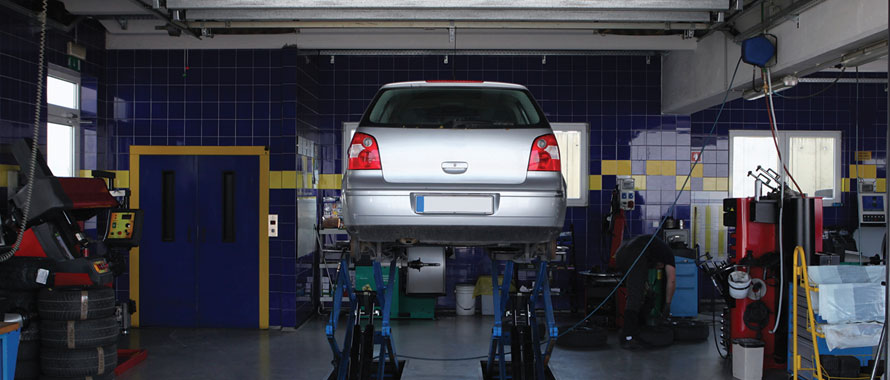The automotive repair and maintenance service industry is a $58 billion market.1 With a total of 227,630 automotive repair shops in the U.S. alone,2 businesses or “garages” associated with this industry need to be properly covered.
“As a trend, we are seeing more and more standard carriers picking up Garage business,” Rebecca Roberts, Managing Director and Transportation Underwriting Manager, Burns & Wilcox. “Automotive facilities, such as auto repair, towing, oil change, classic car restoration, valet parking and salvage facilities benefit from Garage Liability insurance.”
Garage Liability insurance specifically covers property damage, bodily injury and products/completed operations associated with operation of automotive repair or maintenance facilities—not accidents or damage to the actual vehicles.
“Think of Garage Liability as a combination of Commercial General Liability (CGL) insurance and Automotive insurance,” said Roberts. “Garage Liability is specific to risks resulting from the day-to-day operations of an automotive facility.”
When building a Garage Liability policy Mauricio Zani, National Product Leader, Inland Marine, Burns & Wilcox Canada, notes that brokers and agents need to ask the right questions in regards to the type of work, who is involved and who is operating the vehicles.
Brokers and agents should work closely with clients to identify answers to the below questions before coverage is written. A lawsuit stemming from a gap in coverage for property damage or bodily injury in an auto repair facility could put many shops out of business.
1. What type of work is occurring at the shop?
It makes a large difference on the type of work that is occurring in the automotive shop and which insurers will be willing to take on that risk. Failure to disclose what kind of work is occurring could create a gap in coverage or a risk to be improperly rated in accordance with company guidelines.
“Risk can vary between a salvage yard and a dealership, for example,” said Roberts. “If a salvage yard customer slips and falls, the risk may be greater than if the same slip and fall occurred at a dealership, simply based on the surroundings.”
Accidents linked to salvage yard mishaps or heavy equipment in the shop may cause property damage or bodily injury, and can expose business owners to costly legal fees if not properly covered.
2. How many individuals are involved in the business?
“Brokers and agents should know the number of total employees in an automotive facility,” said Zani. “Every person from receptionists and janitors to the actual technicians need to be accounted for.”
Garage Liability insurance covers bodily injury from daily operations, and it goes beyond the individuals who are driving and working on the cars. Larger dealerships with more employees naturally have a greater exposure.
“The severity of Garage Liability risks do not differ between a mom and pop shop or a large dealer, as all accidents are the same,” said Roberts. “One major difference in premium calculation exists in the number and position of employees involved in the businesses operations.”
3. Who is driving the vehicles?
Vehicles being serviced at an automotive repair facility bring their own level of risk. Brokers and agents need to know everyone who may be involved in the operation of a vehicle when it is under the facility’s care.
“Brokers and agents need to know every person who may touch or be in the car,” adds Zani. “For a dealer risk, if an owner or employee takes a car home and a family member drives it, we need to know.”
“It is also important to know the driving history of each vehicle operator to determine a premium rating and who is eligible to operate a vehicle,” said Roberts.
Unlike Dealers Physical Damage or Garage Keeper’s coverage, Garage Liability does not cover the physical damage of an automobile driven for the business or on a daily basis. Garage Liability responds to accidents such as if a pedestrian in struck while the mechanic is test-driving a customer’s car. Garage Liability contains a limit for auto other than auto losses. The auto limit works as a Commercial Auto Liability limit whereas the other than auto works like a General Liability policy.
Other factors impacting Garage Liability
“Location typically has insignificant differences other than pricing in regards to Garage Liability policies, with the exception of no-fault states and provinces,” said Zani.
No-fault areas of the country change these policies, as an accident with an automobile is covered by the customer’s Automobile insurance policy no matter whose fault it is. Currently, there are 12 no-fault states in the United States, and no-fault provinces in Canada include Ontario, Quebec, Saskatchewan and Manitoba.
Garage Liability does not cover every accident associated with the shop. CGL, as well as supplemental insurance, is needed in addition if there are other operations in place, like convenience stores or travel centers.
Like all comprehensive insurance policies, proper coverage starts with asking the right questions. Brokers and agents should consider seeking out a transportation specialist to provide advice and to assist in navigating the sometimes confusing process.




